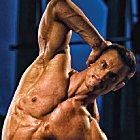 Q: Do you recommend side bends? I can’t recall seeing a photo of a professional bodybuilder performing them.
Q: Do you recommend side bends? I can’t recall seeing a photo of a professional bodybuilder performing them.
A: Just because you don’t see a pro doing side bends doesn’t mean that they’re not a valuable exercise. You won’t see any photographs of the pros doing the L-fly or the finger extension, and you probably won’t see them using a back extension machine or a four-way neck machine. Even so, all five of those exercises have great merit for all bodybuilders.
None of those moves will build substantial muscle mass, which is probably the reason that they’ll never become very popular. What they do do is strengthen neglected and largely hidden muscles, which will help keep you more resistant to injury so that you can progress better in the exercises that will build substantial mass.
The side bend works the obliques—the two layers of muscles (the external and internal obliques) at each side of the waist. You may have seen photographs of famous old-time bodybuilders and strongmen such as Eugen Sandow and Siegmund Klein. They had substantial development of their obliques, but they didn’t get it from side bends. They got it from heavy, overhead, one-arm lifts that involved substantial lateral movement.
Discard any thought that you can overdevelop your obliques. The chance is miniscule. If you get to the point where you’re using a dumbbell heavier than 125 pounds for side bends (for a man), and your external oblique is as developed as you want it to be, stop progressing in poundage. Instead, just maintain that level of development. Still, few bodybuilders will get to that level.
The price you would pay for not doing side bends is to miss out on an exercise that has the potential to strengthen greatly important muscles in your core structure.
The side bend doesn’t work just the obliques. It also heavily hits the abs and the quadratus lumborum, the deep, hidden muscle on either side of the lower spine that helps form the rear of the abdominal wall. The side bend also provides direct work for some of the small muscles around and between the bones of the spine.
What’s more, some development of the external obliques adds a terrific sweep to the sides of the waist—provided that the bodyfat is low enough for them to be visible.
Here’s how to perform standing dumbbell side bends:
Take a dumbbell in your right hand and space your feet a hip width apart or a little wider. Rest your left hand on your left hip. Bend to your right side as far as feels comfortable, and pause for a second. As you bend to your right, push your hips a little to your left. As you return to the vertical position, move your torso first, then your hips. Once you’re vertical, continue the motion as far as you comfortably can to the other side to get a full range of motion, and then return to the vertical position. That’s one rep. Pause for a second, and perform the next rep. Do all your reps to the right side without interruption. To exercise the other side, reverse the procedure.
After an intensive set of side bends, take two or three minutes’ rest before working your other side, so that your performance on the latter doesn’t suffer. Alternate the side you work first from workout to workout.
Face forward throughout each set. There should be lateral movement only. Don’t lean forward, don’t lean back, and don’t overstretch.
Do the reps smoothly—about three seconds down and three seconds up, plus a pause for a second at the bottom and another at the top. Inhale on the descent, and exhale on the ascent, or just breathe freely.
There’s also the pulley side bend. Use a low-pulley cable. Stand sideways to the apparatus, with the handle in the hand that’s nearest to the apparatus. Stand far enough away that the plates can’t come down all the way to rest at the bottom position. Line up the pulley with your ankle and the direction of the cable with the center of the side of your hip, to keep the resistance in the same vertical plane as your body. Then follow the directions for dumbbell side bends.
Adapt carefully to the side bend if you’ve not done it before—or if you’ve not done it for a while. For two weeks do it twice weekly without added resistance, two sets of high reps for each side. Start with your hands akimbo, and then progress to crossing your arms at your chest and then to placing your hands on top of your head. If your flexibility increases, you may be able to increase the depth a little during the first few weeks. Progress gradually.
In your third week of side bends start to use a dumbbell. Add poundage gradually over time, using small increments.
You can also do dumbbell side bend while seated at the end of a bench, with one foot on the floor on each side. With a wide enough foot placement to maintain balance, the seated side bend can work well.
Caution—the side bend is an asymmetrical exercise. Provided you have a healthy spine and you perform it with correct form, the side bend will strengthen your body’s core muscles and increase their robustness and resistance to injury. If, however, you have back problems, you want to avoid this exercise. Get treatment to correct the problems, and then start on the side bend. In the meantime, the rotary torso machine may be a safe alternative.
—Stuart McRobert
www.Hardgainer.com
Editor’s note: Stuart McRobert’s first byline in IRON MAN appeared in 1981. He’s the author of the new BRAWN series, Book 1: How to Build Up to 50 Pounds of Muscle the Natural Way, available from Home Gym Warehouse, (800) 447-0008 or www.Home-Gym.com.




















You must be logged in to post a comment Login